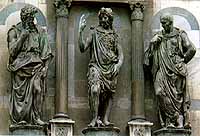
Baptistery, the St.John above the north door
After their conversion to Christianity, the Florentines chose John the Baptist as the city's patron saint. There were probably for two main reasons behind this choice. Firstly because the god Mars had been the previous protector of the city (his statue stood by the Ponte Vecchio until 1333, when it was swept away by the Arno in flood) and St. John, with his courageous and warlike character, must have seemed a worthy substitute. Secondly because the teachings of St. John were short and direct. He said to the publicans: "Exact no more than that which is appointed you". To the soldiers: "Do violence to no man, neither accuse any falsely; and be content with your wages". To the people: "he that hath two coats, let him impart to him that hath none; and he that hath meat, let him do likewise". To Herod: "it is not lawful for thee to have her"(his brother's wife).

The two sides
of the gold florin
He was therefore an upright and inflexible man, the ideal protector for a comunity whose wealth was based on commerce and to whom reputation was like ready money (a clear proof of this came not long afterwards with the invention of the cheque and bill of exchange). The effigy of the Saint was engraved on one side of the the golden florin (with the Florentine lily on the reverse), minted from 1252 onwards. Therefore the coin that represented the wealth and reputation of the Republic also used the patron saint of the city to guarantee the quality of the metal alloy whose composition had always to contain 3,54 grams of gold. This gave rise to a local saying: "St. John will have no cheating". However we do not find St. John the Baptist as the chosen patron saint of Christian Florence until the time of the domination of the Longobards who ruled over most of the Italian peninsula between the 6th and 8th century. St. John the Baptist had already been chosen by the Longobards as their patron saint and they probably "imported" him to Florence on their arrival; they also founded or refounded the Baptistery (VI-VII secolo), "beautiful San Giovanni" (as Dante called it), which, according to legend, was originally a temple to Mars (this was where the statue of the god that stood on the Ponte Vecchio until 1333 came from).

The Cart of St. John
Documents do not however mention any solemn ceremonies to celebrate June
24th, the Patron Saint's feast day, until the 13th century. At the time,
the square and the temple of San Giovanni represented
the main centre of the religious and political life of the Republic, thus,
every June 24th, a series of celebrations were enacted in front of its doors:
an enormous wax candle was brought here on a cart and accompanied by a procession,
that started out in Piazza della Signoria.
This was the origin of the traditional Cart of St. John,
which was later reserved (as it still is today) for the Easter celebrations.
Nowadays the Patron Saint is celebrated with the feasting and fireworks that
are set off at Piazzale Michelangelo on the evening
of June 24th. The ceremonies are still organized by the Society of St. John the
Baptist, founded by Grand Duke Ferdinando III of Lorraine on January 29th 1796
to carry out this specific function.
